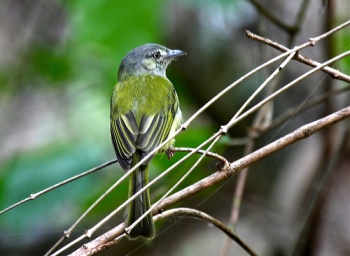Alternative name: Yellow-olive Flycatcher
- Tolmomyias sulphurescens
Identification

Photo © by Coati
Rio Negro, Rincon de la Vieja National Park, Costa Rica, May 2010
13–15·5 cm (5-6 in)
- Olive upperparts
- Grey head
- White lores
- Pale iris
- Narrow eye-ring
- Dark wings with yellow edging
- Two yellow wing-bars
- Flat bill, black upper mandible ; pale lower mandible
- Pale throat
- Olive breast
- Pale yellow belly.
Similar Species
Distinguished from the very similar Yellow-margined Flatbill by the pale iris.
Distribution
From Oaxaca in Mexico through Central America and South America except Chile and most of Argentina.
Taxonomy
Subspecies
16 subspecies are recognized[1]:
- T. s. cinereiceps: Tropical southern Mexico (Oaxaca) to Costa Rica
- T. s. flavoolivaceus: Panama (west to Chiriquí on the Pacific slope, and to Colón on the Caribbean slope) and northwestern Colombia (east to southwestern Bolívar)
- T. s. asemus: Western Colombia (Cauca and Magdalena valleys)
- T. s. confusus: Eastern Andes of Colombia to south-western Venezuela and north-eastern Ecuador
- T. s. exortivus: Santa Marta region of northern Colombia to northern Venezuela
- T. s. berlepschi: Trinidad
- T. s. cherriei: Southern Venezuela to the Guianas and northern Amazonian Brazil
- T. s. duidae: Tepuis of south-eastern Venezuela and adjacent north-western Brazil
- T. s. aequatorialis: Western Ecuador and north-western Peru (Tumbes and Piura)
- T. s. peruvianus: South-eastern Ecuador (Loja) and northern Peru (south to Junín)
- T. s. insignis: North-eastern Peru (Loreto) and adjacent western Amazonian Brazil
- T. s. mixtus: North-eastern Brazil (eastern Pará to north-western Maranhão)
- T. s. inornatus: Subtropical south-eastern Peru (northern Puno)
- T. s. pallescens: Eastern Brazil (Minas Gerais) to northern Bolivia and northern Argentina
- T. s. grisescens: Paraguay and northern Argentina (eastern Chaco, Formosa and northern Santa Fe)
- T. s. sulphurescens: South-eastern Brazil to eastern Paraguay and north-eastern Argentina
Habitat
They occupy a wide variety of humid and montane forests and forest edges.
Behaviour
Diet
Their diet consists mostly of insects, particularly beetles.
Breeding
The male displays with open quivering wings. They build a hanging nest which is generally conspicuous and has a long cylindrical side entrance leading to the nest chamber.
References
- Clements, J. F., P. C. Rasmussen, T. S. Schulenberg, M. J. Iliff, T. A. Fredericks, J. A. Gerbracht, D. Lepage, A. Spencer, S. M. Billerman, B. L. Sullivan, and C. L. Wood. 2023. The eBird/Clements checklist of Birds of the World: v2023. Downloaded from https://www.birds.cornell.edu/clementschecklist/download/
- Gill, F, D Donsker, and P Rasmussen (Eds). 2024. IOC World Bird List (v 14.2). Doi 10.14344/IOC.ML.14.2. http://www.worldbirdnames.org/
- Handbook of the Birds of the World Alive (retrieved January 2016)
- Avibirds Suriname
- Caballero, I. (2020). Yellow-olive Flycatcher (Tolmomyias sulphurescens), version 1.0. In Birds of the World (J. del Hoyo, A. Elliott, J. Sargatal, D. A. Christie, and E. de Juana, Editors). Cornell Lab of Ornithology, Ithaca, NY, USA. https://doi.org/10.2173/bow.yeofly1.01
Recommended Citation
- BirdForum Opus contributors. (2024) Yellow-olive Flatbill. In: BirdForum, the forum for wild birds and birding. Retrieved 9 November 2024 from https://www.birdforum.net/opus/Yellow-olive_Flatbill
External Links
GSearch checked for 2020 platform.1






